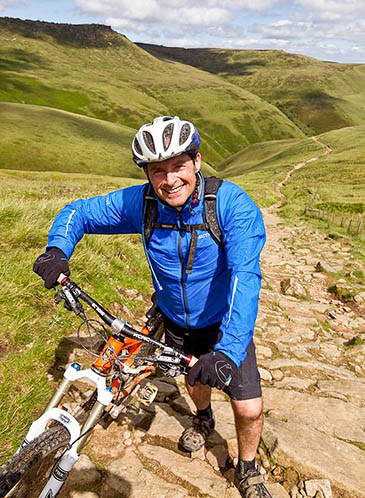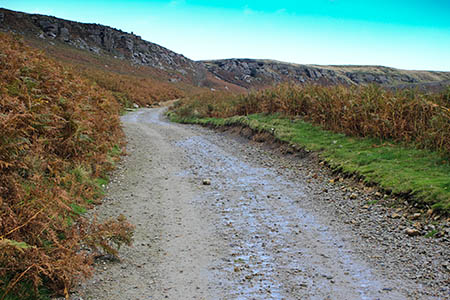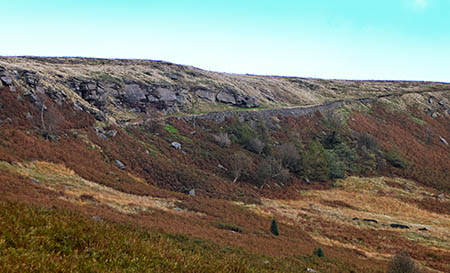Recent changes to rights of way in the Peak District have got mountain bikers hot under the helmet.
Here, in his opinion piece, writer, climber, mountain biker and all-round outdoorsman John Horscroft takes a local authority to task for its recent work on routes in the national park.
It comes to something when a county council has the power to give a perfectly respectable word a bad name.
The word ‘improvement’ is a good sturdy, serviceable word meant to be a sign of good things to come. However, preceded by ‘rights of way’ it can take on an altogether more sinister tone.
Which is where Derbyshire County Council comes in. Over the last couple of years, DCC has carried out a number of ‘rights of way improvements’ that have caused a good deal of controversy in the outdoor community.
DCC is responsible for a variety of trails within the Peak District from footpaths and bridleways to hugely contentious byways such as Chapel Gate and Stanage Causeway.
A multi-use trail in the Peak District has to be a many splendored thing. It has to fit into the landscape, be durable enough to survive the vagaries of the British weather and still be all things to all people.
A challenging rocky trail that may gladden the heart of a mountain biker may be complete anathema to a horse rider or walker and the kind of boulder field that is a real challenge to a 4×4 driver may be pretty much impassable for everyone else.
So how does DCC attempt to square this circle? Stanage Causeway runs through a landscape that is beyond price.
To walkers, climbers, horse riders, mountain bikers and many others it is a world heritage site in all but name. The causeway is a byway open to all traffic that is currently the subject of a traffic regulation order owing to damage caused to an ancient retaining wall by the volume of 4×4 traffic.
It was undoubtedly a mess, a boulder strewn, ankle turning, bike-upending obstacle course that turned into a stream during heavy rain. While talking to an employee of the national park authority a couple of years back, I learned that they intended to do some maintenance work on the trail.
In deference to the various user groups, the idea was to create a trail that looked as natural as possible with a smooth line for walkers and horse riders and a rockier line for mountain bikers.
In April 2013 it became apparent that a cash-strapped national park had delegated the work to DCC who, in time-honoured fashion, consulted no one and simply blitzed the trail with tonnes of crushed gritstone, generating a mighty froth on outdoor websites.
Some contended that it was simply a highway authority doing its job while others bemoaned the expense, still more objected to the visual intrusion on a cherished landscape.
A few mountain bikers bemoaned the loss of a challenge and even those who felt that something needed to be done criticised the result.
Depressingly however, much of the response degenerated into internecine conflict as walkers vilified mountain bikers for erosion and poor trail etiquette and mountain bikers counter-claimed that ramblers cause erosion too, which qualifies as Olympic-standard missing the point.
It’s difficult to over-state just how ill-judged DCC’s repairs were on at least three counts.
At the time there were strong rumours that the national park authority was on the verge of introducing a permanent TRO banning 4×4’s from the causeway, rendering repairs on this scale redundant.
The rumours proved true and a TRO was duly implemented in September 2013. Wasting £30,000 of public money is clearly unacceptable at a time of draconian cuts in council services.
Second, the utter contempt for the landscape was breathtaking. I was informed by DCC that the superb and ancient gritstone retaining wall that supports the road was to be replaced with something more ‘engineered’.
The idea that a local authority would show such cavalier disregard for a piece of industrial heritage in the midst of land that is not only a site of special scientific interest but a special area of conservation was mystifying.
Once I’d spoken to the national park, Natural England and English Heritage all of whom expressed grave reservations about the proposed work, I was left with the distinct impression that where right-thinking people worry about the conservation of a priceless landscape, DCC merely consider it an engineering problem on which to squander incredibly scarce resources.
Finally, is it appropriate in this day and age for a local authority to carry out work on this scale and in such a valuable landscape without any kind of consultation with interested parties?
I’ve heard all the arguments from DCC, that it’s ‘not required to consult where repairing highways as part of its statutory duties’, ‘it prolongs the process’ and ‘achieves little’.
Meanwhile, all over the Peak, the Eastern Moors Partnership, the Wildlife Trusts and the Sheffield Moors Partnership now see consultation as the norm.
While it may slow the process initially, in the long term bringing user groups together encourages mutual understanding and compromise.
Far from increasing costs it has resulted, on a number of occasions, in solutions that are less intrusive than first proposed often carried out with the help of volunteers.
DCC’s reservations are therefore turned on their head – consultation fosters both conflict resolution and saves money.
Equally as relevant is the enlightened attitude of Sheffield City Council rights of way team. If a neighbouring local authority can cooperate with user groups, why can’t DCC?
However, DCC seem impervious to logic. The latest travesty has been perpetrated on the 800m of Wigley Lane above the village of Rowland.
In this case, it was a commonly held view that something had to be done but, true to type, DCC went for the nuclear option flattening the trail with, of all things, road planings.
As a result, the use of an inappropriate waste material of doubtful long-term suitability has already resulted in a dangerously loose top surface at an unbelievably astronomical price of £60,000.
But times are changing. Pressure is growing amongst environmental professionals for a more sympathetic attitude to the environment when rights of way are being maintained.
Surely all user groups can agree that trail maintenance should blend in with the landscape, avoid the intervention of large scale equipment and only use native materials, sourced on site wherever possible.
A well maintained trail enhances the landscape and is a pleasure to use. An ill conceived, over-engineered, proto-motorway built of tar-impregnated road planings is an affront to the principles upon which the national park was founded.
Surely we can all agree on that.



Alan
17 October 2013These people have been to universities and got degrees.
Who are we, we are just mortals that do not understand !
DCC know better than us - SO THEY SAY
heliboarder
17 October 2013Whilst your opinion is valued and no doubt a strong minded one, perhaps spare a thought for less able bodied persons who would benefit from easier access to the great outdoors, perhaps this track is now mobility scooter freindly and walking stick ready could afford a more elderly access also.
Spare a thought for the kayakers out there who are struggling to gain access on to rivers at least mountain bikers have tracks. You've never had it so good. So get out there and erode, erode, erode!
James
17 October 2013As a walker, horse rider, climber and mountain biker, I completely agree. There is no room in the Peak District for Derbyshire County Council's ignorant, inconsiderate, and expensive actions.
John Horscroft
18 October 2013Hi Heliboarder. I'm a big supporter of access for all, but we have to give the landscape a chance. We can't create motorways like this everywhere! As for kayakers, I'm with you all the way. It's a disgrace how little access they have to rivers in GB.
Nigel Styring
19 October 2013Living in Sheffield,a major industrial city,it is a godsend to have such a beautiful national park on our doorstep. |I visit the Peak District often and wonder at the beauty it bestows. I am a firm believer that our national parks should remain as untouched as is humanly possible so that visitors can enjoy the natural beauty.STOP CARVING UP OUR COUNTRYSIDE !
rambler2011
19 October 2013Tarmac Tailings, Chirt chippings, strewn across the landscape where will DCC stop their destruction of the landscape. They obviously have little or no understanding of what is really required do they, they should leave these repairs to the PDNPA. Oh I forgot the DCC is responsible for work on "highways ?" they will be back to tarmac the lanes next week.
John Horscroft
21 October 2013Interesting point rambler2011. If the PDNPA lack the resources to carry out repairs but understand the requirements of different user groups batter, surely some kind of partnership between them and DCC would guarantee a better and probably cheaper result. If the two were to pool resources, the National Park might end up with rights of way to be proud of!
Mike
04 November 2013Well stated Mr. Horscroft
Andrew Willoughby
06 November 2013I'm struggling to see what the problem is here, with DCC providing a fairly natural surface that enables us to walk or cycle. In North Yorkshire we have the County Council wanting to tarmac bridleways to please the cyclists with lightweight bikes and narrow tyres.
Nick Oakes
17 November 2013id just like to say that over the past 35 yrs of visiting the peaks, one of the main attractions is its NATURAL environment!
The focus yet again seems to be making access for all by the easiest way possible, with as little effort in thinking, planning or brainstorming.
instead of simply laying a FLATISH surfice for all, why not channel efforts into improving the practical and machanical means on which people can travel along these beautiful trails.
Are we forgetting that:
Walkers have legs.
Climbers too!
MOuntain Bikes are So well manufactured and designed, they can easily encounter the most rugged surfaces and places!
Wheelchair users need more adaptable equipment, but the technology and means are all ready out there.
So that just leaves 4 x 4s!!
Maybe these are the real benefactors in all this!
I have a Discovery2 Land Rover but have no interest in driving it around this beautiful place, other than to park below Stanage Edge, then Walk to my desired location.
Please Please can we start to value and protect what is out National Heritage, before its completely wrecked in the name of progress and laziness!!!!!
Black Harry
19 November 2013What about the entirely artificial surfaces that now 'grace' the 3 peaks in YDNPA and Kinder Scout in the PDNPA?
They are the kind of thing you would expect to encounter in a shopping mall.
But because they have been installed to repair the damage done by walkers, and walkers alone, no one dare mention them.
I'm also puzzled by the reference to the Peak District as a 'natural' landscape.
If it was natural it would be oak scrubland and peat bog.
It's actually a 'post-industrial' landscape: much altered by mining, quarrying and agriculture. Those drystone walls didn't put themselves up, you know.
Hilariously, one of the 'natural' features that the PDNPA is seeking to preserve in its list of excuses for a Traffic Regulation Order on Leys Lane is ...wait for it...a LEAD MINE!
It's 200 yards from the course of the road, but any excuse is a good excuse for Mr Pennell, eh?
Gary
23 November 2013Black Harry - pedantic - and perhaps missing some great points.
Max
06 December 2013If North Yorks CC are tarmac-ing bridleways, it will not be to 'please' any form of cyclist. Their highways dept are interested in roads for vehicles and nowt else.
Yes, these are post-industrial landscapes, altered irrevocably by man. However, they are not town-centre parks and greens and their points of access should reflect this.
Kayakers should have greater access to rivers and banks but that is a land-owner issue largely and to do with riparian access - not the point of this article.
Chaussures de Sport Adidas
27 May 2015Howeverlast month, I sawa TV interview, a professor let people learn toabandonsometimes, and they could acquisition more. He explainedthat heunderstandingaa person who was not good atstudying, yet he was skilled in cooking, so that he inspired the person to give up studying the major|learn|continue his education|continue his major} that bad atand going a cook. And now|today|nowadays|recently|, the young man is a celebrated cook, itattest that quit is not a evil thing.